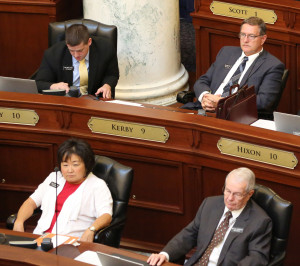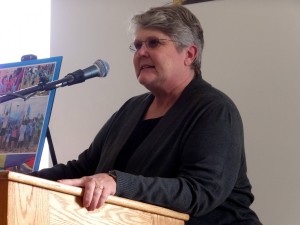The way Idaho school administrators reported teacher evaluations to the state makes it impossible to identify the top- and low-performing teachers in more than one-fourth of Idaho’s 115 districts.
Administrators from 32 districts gave every teacher identical, overall scores of “proficient” during 2013-14 evaluations, according to an Idaho Ed News analysis of data obtained under the Idaho Public Records Act. No teachers in these districts received scores of “distinguished,” “below basic” or “unsatisfactory” — the other three scores within the evaluation system — according to records released by the Idaho State Department of Education.
In an additional 34 districts, nearly every evaluation was returned with a score of “proficient.”For example, Idaho Falls administrators scored 529 total evaluations, with all but one scored “proficient.”
In Lewiston, administrators scored 325 evaluations, with all but two “proficient.”
Teacher evaluations are important because, for the first time, they will be partially tied to teacher pay and the expenditure of an estimated $125 million in taxpayers’ money through the career ladder pay plan being rolled out over the next five years.
According to 2013-14 records obtained by Idaho Ed News:
- Just 0.2 percent of the state’s teachers received scores of “unsatisfactory,” representing 33 of the state’s 17,365 teachers.
- Only 2 percent of all teachers received scores of “basic.” This equates to 352 of Idaho’s 17,365 teachers.
- A vast majority, more than 82.8 percent of teachers, were graded as “proficient.” This translates to 14,372 teachers statewide.
- The remaining 14.9 percent of teachers, or 2,593 educators statewide, earned overall scores of “distinguished.”
- In Boise, Idaho’s second-largest district, 99.4 percent of teachers received scores of “proficient.” That corresponds to 1,610 of the 1,620 teachers identified in the state report. Boise did not award any “distinguished” scores, while five evaluations were scored as “basic” and another five were scored “unsatisfactory.”
- More than 97 percent of Idaho teachers received “distinguished” or “proficient” scores.
- The 32 districts that issued every teacher a score of proficient account for 27 percent of all Idaho districts. These districts have as few as a dozen teachers, or staffs in the hundreds. In Vallivue, for example, all 416 teachers earned scores of proficient. (A complete list of these 32 districts appears at the bottom of this article.)
- The state returned no evaluation data whatsoever for the Middleton district and a handful of small charter schools.
“That’s unconscionable,” West Ada Superintendent Linda Clark said of the identical evaluations. “People are not the same.”
In Clark’s district, 54.6 percent of the teachers’ evaluations were scored “proficient,” 44.5 percent were scored “distinguished” and less than 1 percent were scored “basic.”

New Plymouth superintendent Ryan Kerby, a Republican legislator on the House Education Committee, said he intentionally gave all 59 of his teachers identical evaluation scores.
“Our school district, quite unanimously, did not figure the state needs to know all that individual teacher data,” Kerby said. “We feel the state should be concerned with whether kids are learning, not if Mrs. Smith got proficient or unsatisfactory or basic.”
Kerby twice voted for the career ladder law tying taxpayer dollars to teacher evaluations.
“It’s really not something that the Legislature should be concerned with every Mrs. Smith in fourth grade in New Plymouth,” he said.
What’s in an evaluation?
The state and many of its districts adopted the Charlotte Danielson Framework for Teaching as a measure for teacher performance and as the basis for evaluations. The framework focuses on a teacher’s planning and preparation, classroom environment, instruction and professional responsibilities.
Teachers are issued a score of “distinguished,” “proficient,” “basic” or “unsatisfactory” once all domains and components included in the framework are scored.
Evaluations are required to include at least two documented classroom observations conducted by a building administrator, and a conference with the teacher, which accounts for up to 67 percent of the evaluation. (Districts can also choose to incorporate other factors into this phase of the evaluation — such as student or parent input, student portfolios or elements of a teacher’s annual learning plan.) Student achievement must count for 33 percent of the evaluation.

After evaluations are complete, district employees upload them into the Idaho System of Educational Excellence, the state’s troubled longitudinal data system.
Clark said West Ada has used the evaluation process successfully for more than 30 years.
“Our administrators spend a lot of time supervising teachers and evaluating teachers,” Clark said. “It’s only fair to them to get fair and unbiased observations and evaluations. We believe so strongly, we’ve mandated a second set of eyes for every teacher.”
Clark believes identical scores would be counterproductive.
“If everybody is proficient, how do I have what I need to put a teacher on an improvement plan, probation or terminate a teacher?” Clark said. “If every single teacher is proficient, and I’ve got somebody who is weak somewhere, I’ve undermined my own case by giving him or her a proficient rating and not indicating basic.”
During previous state superintendent Tom Luna’s tenure, Clark said West Ada attempted to send anonymous, aggregated evaluations to the state in an attempt to protect teachers’ privacy. But Clark said she and district leaders reversed course after the state threatened to withhold funding for noncompliance.
Boise Superintendent Don Coberly also stressed the importance of evaluations as a tool to improve teaching and identify areas to target professional development.

“First off, we look at teacher evaluations as a process for improvement,” he said.
But Coberly did not respond to questions and multiple messages about Boise’s 2013-14 evaluation scores, which reported identical “proficient” scores for 99.4 percent of its teachers.
Student performance and teacher evaluations
Christina Linder, an associate dean at Idaho State University’s College of Education, said the Danielson framework was intended to support professional growth and teacher improvement, before it became an evaluation tool. Linder previously oversaw teacher certification as the State Department of Education’s director of certification and professional standards.
Linder is also friends with Danielson and helped advise a subcommittee that issued recommendations for the precursor to the career ladder.
Although Linder said she is passionate about recognizing and rewarding Idaho’s best teachers, she has serious concerns about the validity of Idaho’s evaluations. Linder said people shouldn’t expect the evaluations to be valid unless every administrator who performs them is trained and certified in the evaluation process.
She pointed to inconsistencies in the evaluations — some districts issue four scores (distinguished, proficient, basic and unsatisfactory) while others only use three scores and don’t award distinguished marks.
Eastern Idaho’s Bonneville Joint School District doesn’t even use the Danielson framework, opting instead for the Jordan Performance Appraisal System.
Finally, Linder said it may be a red flag if districts assess 100 percent of their teachers as proficient, yet fail to reach 100 percent student proficiency.
“Wow,” Linder said. “If there are so many good teachers, why are there so many struggling students?”
How evaluations are tied to teacher pay and taxpayer money
The stakes for teacher evaluations have increased in recent years.
After originating as a tool for growth, evaluations have been tied to bigger and bigger programs and compliance issues, including Idaho’s Race to the Top grant application and the state’s waiver from the Elementary and Secondary Education Act/No Child Left Behind. Evaluations were used as a criterion during the economic downturn, when districts cut teaching positions. For years, state leaders have debated tying teacher pay to accountability and student performance.
The 2015 Legislature went a step farther by passing the career ladder, a 34-page law that includes the word “evaluation” 14 times.
In order for a teacher to advance from the initial residency rung on the pay ladder, teachers must earn an overall score of “proficient” or better on evaluations.
Once the career ladder is fully implemented, evaluations will be among several factors districts can use to qualify teachers for master teacher premiums, designed to award higher pay to rockstar teachers with eight or more years’ experience.
But there does not appear to be a cap on the number of master teacher premiums that can be awarded at the district or state level. There may even be a financial incentive for districts to submit all evaluations with scores of “distinguished,” just as many districts submitted all 2013-14 evaluations with scores of “proficient.”

In districts with high student achievement, administrators would theoretically be able to chose evaluations as a criteria for master teacher premiums, submit every experienced teacher’s evaluation with an overall score of “distinguished” and and hope to collect an extra $4,000 per teacher.
Kerby, the House Education member and retiring New Plymouth superintendent, said lawmakers will need to change the career ladder law to improve it and close potential loopholes. One such loophole is the seemingly uncapped master premium funding.
He says some lawmakers left Boise this year knowing that the career ladder — hailed by Gov. Butch Otter as one of the session’s signature achievements — was unfinished.
“It’s not done, everybody knows it’s not done,” Kerby said.
Idaho Education News Data Analyst Randy Schrader collected and mined the data used for this report.
List of school districts where every teacher earned a score of “proficient”:
- Bear Lake
- Bliss
- Butte County
- Cascade
- Castleford
- Challis
- Cottonwood
- Fremont
- Fruitland
- Hagerman
- Highland
- Horseshoe Bend
- Kootenai
- Kuna
- Mackay
- Marsh Valley
- McCall-Donnelly
- Midvale
- Moscow
- Murtaugh
- New Plymouth
- Notus
- Potlatch
- Ririe
- Salmon
- Shelley
- Sugar-Salem
- Teton
- Vallivue
- Wallace
- Weiser
- Wilder
About this data
Districts are required to report teacher evaluation results to the Idaho State Department of Education each year. Idaho Education News Data Analyst Randy Schrader acquired these reports through a series of public records requests to the department.
Department officials sent Ed News the information three separate times. The first time, the data did not show that any of Idaho’s 17,000-plus teacher evaluations were scored “unsatisfactory.”
The second time department officials supplied the data to Ed News, it showed that 33 Idaho teacher evaluations were scored “unsatisfactory.” The report did not show where those teachers worked.
After Schrader repeatedly challenged whether data was redacted inappropriately, State Department of Education officials admitted they had incorrectly redacted data and then provided Ed News with complete evaluations records on Thursday afternoon.
